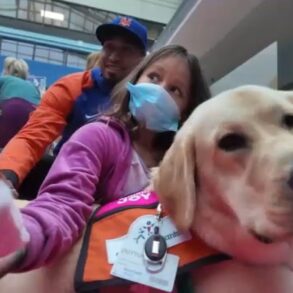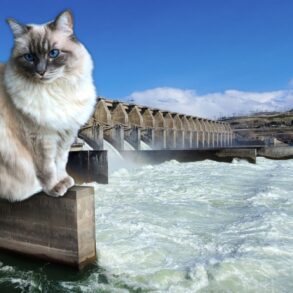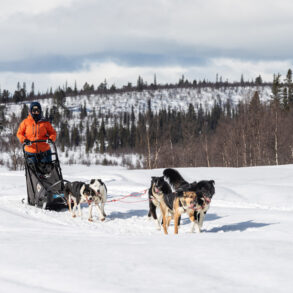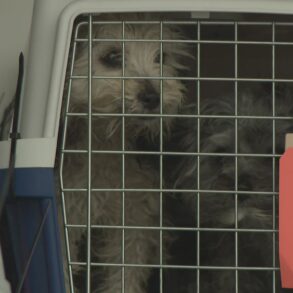If there’s one thing that has the potential to make a day on the slopes even more fun than craving fresh tracks or sipping a hot beverage around the fireplace in a lodge, it’s the sight of dogs happily bounding over the snow. Outfitted in their classic red vests emblazoned with the white cross of ski patrol, they often look like the happiest creatures on the hill. But don’t be fooled; these are working dogs. Avalanche dogs help locate skiers and snowboarders buried in the snow.
Many ski resorts in the western U.S. employ a four-legged workforce alongside human ski patrollers for one reason: They’re excellent at search and rescue, says President of Wasatch Backcountry Rescue (WBR) Andy Van Houten. That’s the non-profit organization that oversees the training and certification of avalanche dogs for 11 ski resorts around Utah.
And being better at finding buried skiers just outside resort boundaries or in the backcountry can mean lives saved during rescues or recovery missions (when an avalanche-buried outdoorist is presumed dead) that end quickly and give loved ones closure in hours instead of days.
Indeed, most missions these dogs go on are unfortunately recovery missions. That’s due to the nature of backcountry skiing: resorts conduct extensive avalanche mitigation efforts on their properties, but in the backcountry, avalanches are much more likely, so exploring these areas comes with much greater risk.
What’s more, backcountry areas tend to be far from resorts and require a rescue team to assemble, take a helicopter to the site, and then locate not just where the avalanche took place, but where in the snow a skier or snowboarder might be buried. That can take up to 60 minutes, Van Houten says.
Fortunately, rescue teams are quick to respond, and if there’s a dog on that team, searches can be over in minutes instead of days. During one particularly deadly avalanche season in Utah in 2018, Van Houten recalls a recovery mission where one of the well-trained dogs found a body in two and a half minutes. “Finding them with just people would have been days of work,” he explains.
That’s because the avalanche dogs who are certified by WBR are near-perfect search machines thanks to years of training, excellent on-snow agility, and an amazing sense of smell.
It all starts with training
Training starts when the dogs—usually labs but occasionally other working dogs like German shepherds or border collies—are puppies. They arrive at the resort they’ll call home for much of their working life in September at just 49 days old and are entrusted to a handler, a fancy name for an owner who will take charge of their training but also care for them like a beloved pet.
That first winter they’ll spend the entire season getting acclimated to resort life and all the sights, sounds, and smells that come with being a rescue dog. Handlers will ski around with puppies in their jackets, ride lifts with them, introduce them to their fellow employees and resort guests, ride in helicopters, and introduce them to the sounds of explosives, the kind required in avalanche mitigation and rescue.

By the end of the season, they’ll begin obedience training and practice drills to build their drive to search and rescue. But if that sounds serious, don’t worry, there’s plenty of play involved. In fact, Van Houten explains that puppies are taught how to find hidden humans with a game: tug of war.
First, the dog is familiarized with human scent thanks to plenty of time with their handler. Then, in what Van Houten calls “runaway drills,” the handler gets the dog excited, tells it to stay, runs away and hides, then, when the dog is given the command “search,” they must go and find their hidden handler. When they do, they get to play a game of tug of war with a toy in the handler’s pocket.
“For the dog it’s a big game of hide and seek,” Van Houten says. The training is similar to the principle of Pavlov’s Dog and classical conditioning: once trained, they hear the word “search,” which elicits a response (in this case finding a buried human) that they know results in a reward (a game they enjoy).
As the dogs improve at the game, handlers hide further away or in deeper holes, progressing to caves dug entirely under the snow. Which is where the animals’ next advantage comes in: their sense of smell.
Sniffing out danger
Dogs have a tremendously impressive sense of smell, which makes them exceptional at finding people buried in the snow. While researchers can’t seem to decide on how much more sensitive dogs’ olfactory senses are than humans, it’s safe to say they’re better at locating drugs, bombs, and humans by scent alone than their bipedal companions, and that includes in snowy environments.
That’s because humans release something called skin rafts, Van Houten explains, which are the scent portion of skin cells, at a rate of about 30-40 thousand every minute. These skin rafts are lighter than air, so they percolate up through the snow and collect on top of it in a sort of pool, he continues. As long as handlers can get their dogs into the scent zone, the dog will ping pong around the area until they find the center of it, which is located directly above a buried skier.
“It’s impressive to watch,” says Van Houten. Even more impressive given how quickly dogs can move over snowy landscapes.

Quick on their feet
Indeed, dogs’ agility is what gives them their final edge. Because even if humans were capable of sniffing out these scent pools, they cannot deftly navigate deep snow, especially when paired with avalanche debris like downed trees, which is even harder to maneuver around. Even outfitted with snowshoes, it’s hard to move quickly when you’re sinking into soft powder. Dogs have little trouble bounding over and through it, as anyone who’s let their dog outside after the first snow of the season can attest to.
As a bonus, dogs don’t require layers and layers of protective equipment or specialized gear like people do; they are durable and well-equipped for harsh weather. “This all makes them the ultimate avalanche rescue tool for those who don’t have a beacon,” Van Houten says.
Stay safe out there
Of course, if you’re heading into the mountains in the backcountry in the winter, whether that’s on skis, a snowboard, or on foot, don’t rely solely on these well-equipped and expertly trained animals to save your life. On the contrary, always carry a beacon, rescue tools like a probe and shovel, and consider gear outfitted with locater technology like that from RECCO. Paired with the friendliest, wet-nosed faces you’ll ever spot on the ski slopes, these will help ensure a safe and enjoyable season.
This post was originally published on this site be sure to check out more of their content.











































